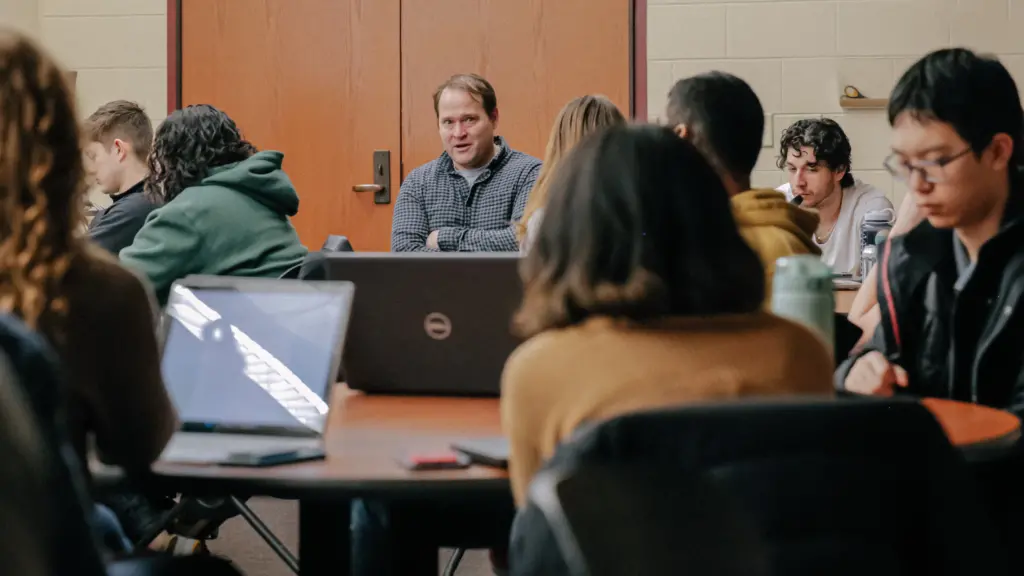As Everett Cartier prepared for his group’s venture capital pitch in support of an advanced arm prosthetic, he knew he’d be facing a tough audience.
Never mind that it was purely a mock VC pitch, a group project as part of a biomedical engineering course at the University of Wisconsin-Madison. The class instructor, Associate Professor Kip Ludwig, had been a program officer at the National Institutes of Health (NIH) who years ago actually evaluated the revolutionary—and complex—device for funding.
“This is right up his alley,” says Cartier, a student from Brookfield, Wisconsin, in the Department of Biomedical Engineering’s one-year master’s program in biomedical innovation, design, and entrepreneurship. “That’s why I was like, ‘I’ve got to have backup slides, I’ve got to be ready to meet him at his level in some capacity.’ Definitely preparing more than you need to.”
Ludwig’s BME 640: Medical Devices Ecosystem: The Path to Product course puts students in the shoes of medical device entrepreneurs by having them choose either an existing startup to analyze or their own novel idea to explore. Cartier’s group, for example, picked the LUKE arm, created by New Hampshire-based DEKA Research & Development. Other groups work on devices they developed in the department’s hands-on undergraduate design curriculum or on independent startup ideas.
Over the course of a semester, Ludwig leads the class through the litany of considerations startups must surmount when taking a device from idea to ready for market: gap and market analyses, intellectual property, insurance reimbursement, regulatory pathways, preclinical and clinical testing, manufacturing practices, supply chain sourcing, funding sources and more.
“No one designs a medical device by themselves,” says Ludwig. “This is all about teamwork. This is all about creating relationships and researching similar things that have gone through to learn as much as you can, in terms of how they worked and how they failed, so that you can create better devices.”
Ludwig speaks from firsthand experience. He started his career at a medical device startup and evaluated devices for funding in his role at the NIH. He’s a member of several companies’ advisory boards and has co-founded two startups: Neuronoff, based on his work on an injectable electrode, and NeuroWorx, a newer venture around neuromodulation treatments —electrical stimulation of nerves—for Alzheimer’s and Parkinson’s disease. He arrived at one class fresh off his own multimillion-dollar VC pitch.
 Associate Professor Kip Ludwig spent four years as the program director for neural engineering at the National Institutes of Health. Photo: Tom Ziemer.
Associate Professor Kip Ludwig spent four years as the program director for neural engineering at the National Institutes of Health. Photo: Tom Ziemer.
“I try to be very transparent about what I’ve seen—within the bounds of any confidentiality agreements,” says Ludwig, who’s keen to help the mix of undergraduate and graduate students avoid some of the on-the-job learning he faced upon entering the industry. He says he’s gotten several emails from past students who leveraged their work in the class in successful job interviews.
Since Ludwig started teaching the course as a special topics offering in 2018, student interest has ballooned, to the point that he more than doubled enrollment capacity this semester. Along with their VC pitches and another presentation detailing hazard and failure modes and effects analyses, the students are graded on the feedback they provide on other groups’ sessions—a charge they clearly take seriously.
Cartier and his groupmates faced detailed questions about market size and specific pieces of the company’s patents. Another group, studying Boston-based Miach Orthopaedics, fielded inquiries about the length of the company’s clinical trials, the size of the incision in the alternative anterior cruciate ligament repair procedure, and criteria for patient eligibility. And Ludwig researches each company—or, in the case of student startup ideas, market space—to pepper the students with tough questions.
It’s part of pushing them to stay curious and adaptable, the sort of lifelong learning habits that are essential in such a fast-changing field.
“You get out of date really quick. There’s no textbook for a lot of this. Regulations change, suppliers change,” says Ludwig. “One of the things that makes this class possible is the unique environment at UW-Madison, that we are in what’s considered medical device alley. And that the structure here allows us as instructors to have our own research programs, develop intellectual property, spin out small businesses, sit on advisory boards for major companies, do advisory work for investment firms. I do all of those things, with the goal of keeping up on it to bring it back to the students.”
Top photo caption: Students Everett Cartier, Xiangfei Wang, Isaac Krause and Ryan Meekin present their research on an advanced arm prosthetic. Photo: Tom Ziemer.